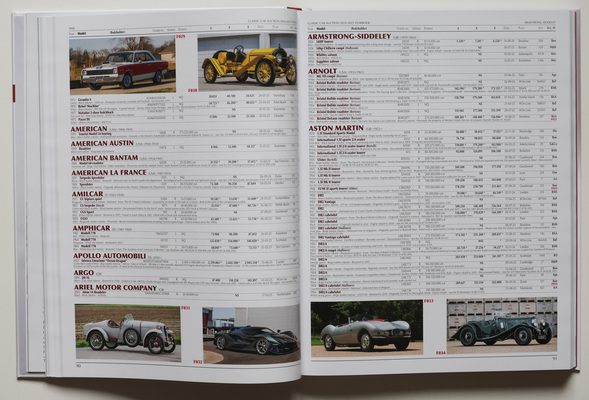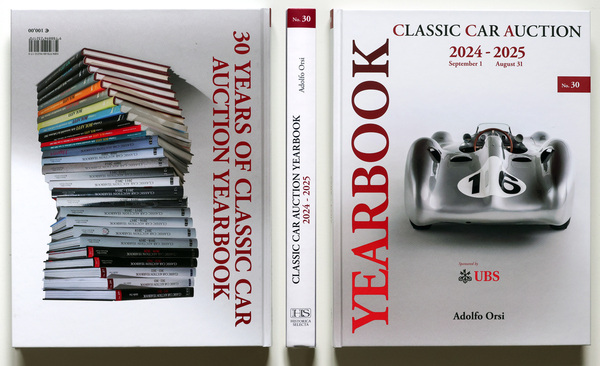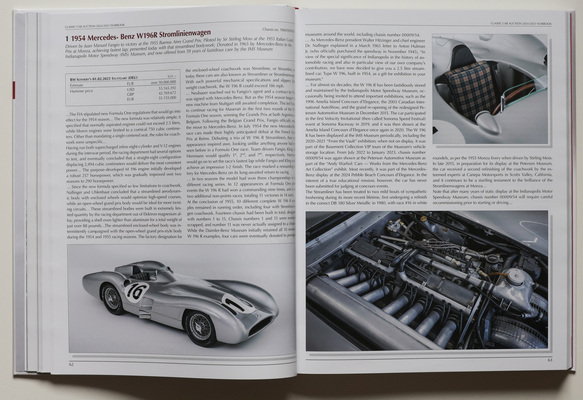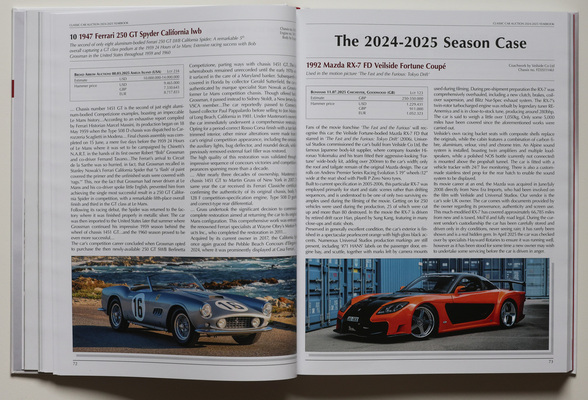The "Classic Car Auction Yearbook 2024 - 2025" is the 30th edition of the review of the past auction period, which extends from September 1, 2024 to August 31, 2025 and has now become a standard work among auction houses, classic car specialists and enthusiasts.
Once again, Adolfo Orsi and his team analyzed the results of 87 live auctions plus relevant online-only auctions, which now account for around a third of the coverage.
The auction industry is constantly changing, Gooding was taken over by Christie's, Broad Arrow is getting bigger every year and took over many specialists from its competitors, Bonhams is fighting for its place in the top league. New players and in particular the constantly growing online sector with bring-a-trailer at the forefront are influencing the market.

Nevertheless, the balance of power remains relatively constant from year to year and the companies represented with a market analysis in the front section of the book - Artcurial, Bonhams, Broad Arrow, Gooding Christie's, Mecum and RM Sotheby's - are largely the same as in the previous year. These votes in particular are interesting to read, as exciting insights from the auction house representatives shine through time and again.
A central theme throughout the book is the generational shift that is currently taking place. Younger buyers with a lot of money are clearly choosing different cars than the generation that bought vehicles at auction in previous decades. In fact, more and more auction houses are offering young and very young cars, often produced in strictly limited series. These are celebrating one sales record after another and sometimes make the super classics of the fifties and sixties look really old. However, the particularly legendary cars, such as the Ford GT40, Ferrari 250 GT California Spider and Mercedes-Benz 300 SL mentioned in the Yearbook, are holding up well in this new competitive situation and have retained their iconic status. This also applies to other classics such as the Lamborghini Miura, but especially to more recent collector's cars such as the Ford GT, the Porsche Carrera GT or the Ferrari F40.
Many evaluations and analyses
The many graphics in the 472-page book are exciting every year. The value development of specific vehicles (a chassis number) is analyzed, including cars from Bugatti, Ferrari, Bentley and Koenigsegg. And only a few of these vehicles have cost their owners money; most have increased in value over the last 30 years. There are exceptions, particularly in the case of pre-war classics.

It is also impressive to follow the value development of certain vehicle types over 30 years, e.g. the meteoric rise of the 300 SL Gullwing or the "field hockey stick" of the Ferrari F40. Some of these price curves reached their peak in the mid-teens of the 21st century, others are still on a steep incline. Some collector cars also see a hype peak and then a fading of the star.
According to Orsi, USD 2.18 billion was realized at auctions with 11,725 cars in the period under review, 73% of the cars were sold. The proportion of no-reserve cars rose again after falling in the previous year. Around a third of the 11,725 cars were sold online. Three quarters of sales were recorded in the USA.
The average price per car fell compared to the previous year, as did the number of cars sold for more than one million American dollars.
Ferrari continues to top the sales rankings, followed by Porsche and Mercedes-Benz. However, young brands such as Pagani, RUF and Singer are becoming increasingly present in this list. And these three brands in particular also achieve significantly higher average prices per transaction. Orsi's market analysis runs to ten pages and is well worth studying in detail. He points out, for example, that the Ferrari 250 GTO, which began to boom in the 1980s, was 25 years old at the time, just like the super and hyper sports cars that currently seem to be getting more expensive year on year.

An additional compilation in the Yearbook is the 20 most expensive Grand Prix and F1 cars sold at auction between 1993 and 2025. Interestingly, the first three places are occupied by Mercedes-Benz racing cars (two W196Rs from the 1950s and a W04 from 2013), followed by two Ferraris, an Alfa Romeo, three other Ferraris and a McLaren.
The most expensive cars
As every year, Orsi and his team analyze and describe the most expensive cars sold.

In the current book, these are the Mercedes-Benz W196R from 1954, the Ferrari 250 LM from the Indianapolis Museum built in 1964, the surprisingly expensive (and for a good cause)The most expensive Ferrari 250 GT Spyder California from 1961, the F1 Ferrari F2001 from 2001, the Ford GT40 Mk2 by Holman Moody from 1966 (also from the Indinapolis Museum), the Pagani Zonda LM Roadster from 2014, the Ferrari F40 LM from 1993, the Ferrari 375 MM Berlinetta from 1955 and the Ferrari 250 GT LWB Spyder California from 1959.

As a "Season Case", the Yearbook also highlights the 1992 Mazda RX-7 FD Veilside Fortune Coupé from the film "The Fast and the Furios: Tokyo Drift", a car that was auctioned for around three times its estimated value and realized USD 1.123 million or EUR 1.05 million.
The huge "data section"
The data section comprises 345 pages and lists all of the almost 12,000 transactions. The chassis number, the auction results and a brief description are shown for each car. Of course, this is primarily a reference work; hardly anyone will want to look through it page by page.

Major brands are represented by many pages, while exotic brands such as American Bantam, Berkeley or Pope-Hartford have to make do with one entry. When you browse through Lamborghini, for example, you realize just how high the proportion of young cars at auction has become.
Entertaining look back over 30 years
As already mentioned, the new issue is already the thirtieth. Accordingly, Orsi decided to take a somewhat more extensive look back at past editions. To do this, however, you have to turn the book over and read it from the back, so to speak. There you will find summaries of all previous editions and can also read which ten cars were the most expensive in each year. In 1993-1994, for example, only one of the top 10 cars was from the post-war period. This was a Jaguar C-Type from 1953, which was auctioned for USD 381,322.

The following year, four post-war cars made it into the top 10, but there were no seven-figure auction results.
A look back to the nineties brings tears to the eyes, because back then there was still a Ferrari 250 LM for less than USD 600,000.

From the 2000s onwards, however, values in the millions were the norm in the top 10 lists of the auction year and there were early outliers at the top.
These glimpses into the past alone are a selling point for the book, which costs EUR 100 / CHF 95. However, anyone who has the previous editions in their collection will hardly hesitate. Anyone coming across it for the first time will probably be won over by its enormous scope and the meticulousness of the Orsi team.
Bibliographical details
- Title: The Classic Car Auction Yearbook 2024 - 2025
- Author/Editor: Adolfo Orsi
- Language: English
- Publisher: Historica Selecta SRL
- Edition: 1st edition October 2025
- Format: Hardcover, 24.3 x 31.5 cm
- Size: 472 pages, 1015 color photos and 107 graphics
- Price: EUR 100 / CHF 95
- ISBN: 978-88-96232-17-0
- Buy/order: Online at BM Classics or at other booksellers recommended by Historica Selecta




























